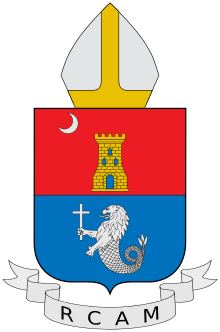TV Maria
TV Maria is a national Catholic television channel broadcasting from Manila, Philippines. Owned by TV Maria Foundation Philippines (a non-profit, non-stock organization under the Catholic Bishops' Conference of the Philippines and the Roman Catholic Archdiocese of Manila), it airs 24 hours a day and is currently available on major and provincial cable operators, on digital terrestrial television broadcasts via RJ Digital TV's DTT subchannel in Mega Manila, and via online livestreaming.
| TV Maria | |
|---|---|
| Launched | January 1, 2006 (test broadcast) December 8, 2007 (full launch) |
| Owned by | Roman Catholic Archdiocese of Manila Catholic Bishops' Conference of the Philippines TV Maria Foundation Philippines, Inc. |
| Picture format | 480i (SDTV) |
| Slogan | The Filipino Catholic TV Channel Umaakay sa Kaganapan ng Buhay (Leading You to the Fullness of life) |
| Country | Philippines |
| Language | English Filipino Tagalog |
| Broadcast area | Nationwide |
| Headquarters | Manila Philippines |
| Website | www |
Availability | |
| Terrestrial | |
| Digital terrestrial television (Via RJ DigiTV) | Channel 29.05 (Metro Manila) |
| Satellite | |
| Sky Direct (Nationwide) | Channel 49 |
| SatLite (Nationwide) | Channel 103 |
| Cignal Digital TV (Nationwide) | Channel 188 |
| Cable | |
| Destiny Cable (Metro and Mega Manila) | Channel 210 (Digital) |
| SkyCable (Metro Manila and GMA - CAMANAVA/Rizal only) | Channel 210 (Digital) |
| SkyCable (Lipa, Batangas) | Channel 2 (Analog) |
Most of the station's programmes are both in-house productions and packaged shows from Jesuit Communications Foundation, Kerygma Foundation, Family Rosary Crusade, Society of St. Paul, and other Catholic groups.
History
The Roman Catholic Church recognizes the importance of keeping up with the times to reach out to a greater number of people. And TV Maria is its means to cater to a Filipino audience who are hungry for God's Word through television as well as through various alternatives such as the internet and the cellphone.
TV Maria Foundation Philippines, Inc. – or simply known as TV Maria – is a non-profit, non-stock religious organization of the Catholic Bishops' Conference of the Philippines through the Roman Catholic Archdiocese of Manila. Its work mainly involves evangelizing the Catholic faith through television and internet broadcasting, plus other forms of modern communication. It promotes not only the importance of communication and information in building a nation but also the importance of interweaving these with Catholic Filipino values.
TV Maria began test broadcasting on January 1, 2006 and began regular transmission on December 4, 2006, the Feast of the Immaculate Conception.[1]
On August 13, 2013, during a press conference for the upcoming Philippine Conference on New Evangelization, Archbishop of Manila Luis Antonio Cardinal Tagle announced that TV Maria finally granted its pay-tv-to-air television franchise from the National Telecommunications Commission.[2]
Starting 2015, TV Maria began to broadcast its Misa Nazareno mass from historic Quiapo Church live via video streaming, as well as certain Papal Masses via EWTN. Since Holy Week 2016, TV Maria also started live broadcasts of Holy Week activities in the Manila Cathedral using widescreen format.
On March 11, 2020, TV Maria was launched on digital terrestrial television on UHF Channel 29 (563.143 MHz) in Metro Manila and surrounding provinces after it signed a partnership deal with Rajah Broadcasting Network.
References
- TV MARIA OFFICIALLY LAUNCHED ON DEC. 8. Katoliko.org. Retrieved Dec. 16, 2007.
- Catholic channel may air on free TV. Rappler. Retrieved August 13, 2014.

